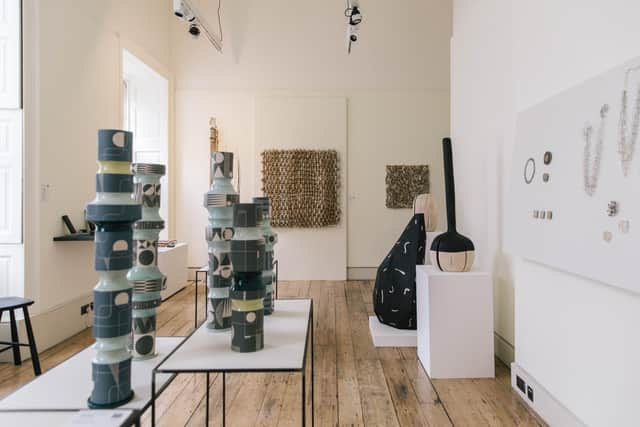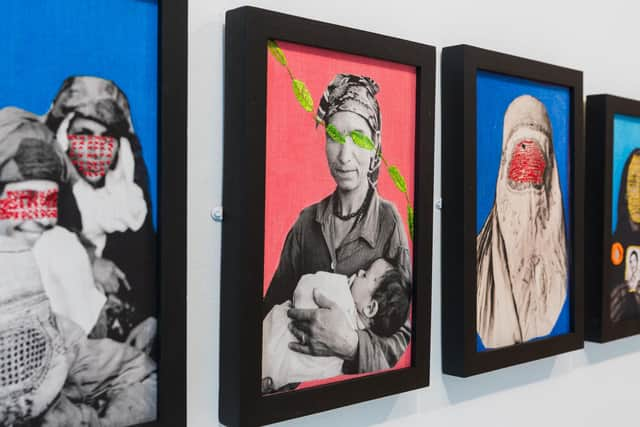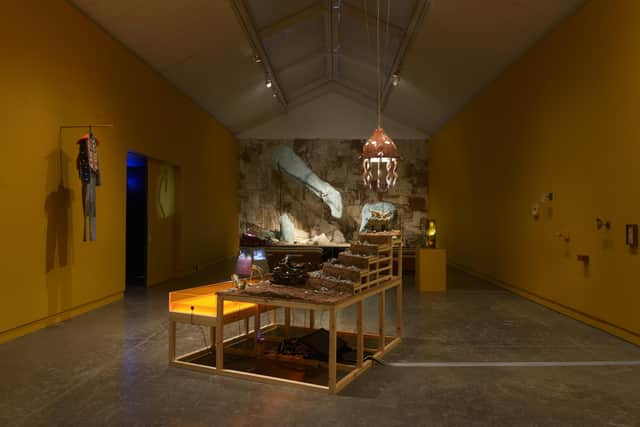Art reviews: Craft Scotland: Close to Hand | Jenny Matthews | Rae-Yen Song
Craft Scotland: Close to Hand, Collect 2024, Somerset House, London ****
Jenny Matthews: Sewing Conflict, Street Level Photoworks, Glasgow ****
Advertisement
Hide AdRae-Yen Song 宋瑞渊: life-bestowing cadaverous soooooooooooooooooooot, CCA, Glasgow ****
The dividing line between art and craft is blurred at best, perhaps it was ever thus. Without question, many of the makers selected for Close to Hand, Craft Scotland’s showcase at the international fair Collect 2024, would not look out of place in a fine art context: rich in ideas, passionately interested in materials, replete with skill.
Collect, which takes place every March in London’s Somerset House, is the UK’s leading fair for contemporary craft, attracting an audience of thousands. For the 12 Scottish makers featured in Close to Hand, the show, curated by Susanna Beaumont, erstwhile owner of Edinburgh’s Doggerfisher Gallery, is a chance to present their work to collectors and curators from around the world.
The show’s title reflects the makers’ intimate relationship with their materials. Sustainability is currently a watchword in craft, with makers like Iona Turner, a recent graduate from GSA, creating jewellery from seaweed gathered on Scottish beaches, and Richard Goldsworthy, a recent graduate from ECA, making his impressive wooden sculptures from storm-felled trees in the Borders.
The work of Fife-based Susie Redman is one of the highlights here. She grows her own flax and willow, making vessel-like forms which are part-fabric, part-basket. They are sculptures, really, curving and leaning, playing with texture and shape and weight. Jo McDonald recycles the pages of old books into ropes of paper and weaves them into tapestries, repositories of stories.


In a fair in which ceramicists predominated, Craft Scotland presented just one, Jo Walker, whose “Piloti” – geometric columns inspired by modernist design – combine a simplicity of form with a richness of detail. Katie Charleson combines textile screenprinting using natural dyes with quilting to make wall-hangings which look a lot like paintings.
Advertisement
Hide AdStefanie Ying Lin Cheong describes the ideas behind her jewellery as “geoanthropology”, tracing time from Scottish rocks millennia old to fragments of concrete and ocean-borne plastics. Silversmith Emma Louise Wilson makes enamelled bowls which evoke the North East coastline, while Heather McDermott’s jewellery is inspired by the sea and by the flotsam and jetsam washed up on the beaches of her home island, Skye. Together, these 12 makers create a snapshot of Scottish craft which is powerfully rooted in place, while ranging far and wide in its imagination.
Many people turned to craft in the pandemic, among them photographer Jenny Matthews, who has spent nearly four decades working in war zones and areas of humanitarian disaster around the world. Locked down in 2020, she began to print her photographs on fabric and collage them into quilts, embroidering them and using colours and fabrics from the countries where they were taken. Twenty-three of these are being shown for the first time this month at Glasgow’s Street Level Photoworks.
Advertisement
Hide AdMatthews’ emphasis has always been on women’s stories. Two large-scale photographs, a child from Sudan and a widow from Afghanistan, demonstrate the power of the images themselves. Why turn them into quilts, especially when the reproduction quality is less vivid on fabric? What does it mean to halo a child’s head in stitches, cover a face with flowers, embroider a barbed wire fence?


If photographs capture moments and present them for immediate impact, then the quilts do something different. Craft takes time, making them a kind of “emotion recollected in tranquillity”. In them, Matthews brings together images of suffering and of resilience. War and trauma and crisis are subjected to a long, tender, hands-on process of making.
Facial Derecognition is a series of portraits of Afghan women, who have lost their freedoms under the Taliban to the extent that their faces and voices are largely hidden. Matthews embellishes the prints with embroidery, often on the face, and dedicates each one to a different group: female artisans, musicians and singers, those who have lost their jobs, those who continue to study in secret. Picture by picture, she reminds us what has been lost.
Looking at Matthews’ back catalogue was always going to be harrowing, the locations alone tell us that: South Sudan, Myanmar, Nicaragua, Iraq, Ukraine, Rwanda. One of the rawest banners comes from Gaza, commemorating the death of writer on 7 December of writer, academic and activist Refaat Alareer along with his brother and sister and their children in a targeted Israeli air strike. Another recent banner shows South Sudan, now forgotten by the world’s media, the images torn and fractured, yet stitched together with care.
One wonders if a retrospective of photographs alone would be unbearable. With stitched works, the impact is softer. One is reminded that stitching is one of the most narrative of crafts, used by women down the centuries to contain and communicate stories. The stories themselves don’t become less harsh, but perhaps those who are to receive them can do so with more compassion.


And now for something entirely contemporary. Yet, in the exhibition “collated” by Rae-Yen Song at CCA, craft is also much in evidence. The show’s complex ideas and diverse imagination is served by a high degree of expert making.
Advertisement
Hide AdDescribed as “a research exhibition and live programme”, the show is a working out of ideas for a larger exhibition by Song in Tramway in 2025. The artist has invited a range of other artists, film-makers, curators and academics to participate in this “laboratory and thinking space”, to “explore and sift”. That means it is fragmented rather than conclusive, but so are many contemporary art shows which claim to be “finished”.
CCA’s three gallery spaces are each assigned an element: water, earth and air. Song is interested in world-building, drawing on mythology, family ritual, ecology, science fiction and their own background in the Scottish-Chinese-Singaporean diaspora. Swirling around under the surface of this show is a creature of the deep, a many-tentacled beast of the past or the future, or possibly both.
Advertisement
Hide AdSong’s own work, an installation called ○ squigoda song cycle ● water~land~air ○, is impressive as ever, including a kombucha tea fungus slowly fermenting in a glass tank. Hand-made ceramic vessels spin slowly on a structure which builds up towards a tentacled being. An immersive soundscape, created with Tommy Perman, throbs and bloops softly around us.
There are too many other works here to mention all the artists by name, but the sea creatures by Aniara Omann, the film by Anne Duk Hee Jordan, the stage installation by Emii Alrai, the superb kinetic sculptures by Hazel Brill which fuse mechanical and organic elements, and the miniature cinemas of Kara Chin all deserve commendations. The last work in the show is what can only be described as a giant sandwich-making machine by Chin, fashioned with care and a good dollop of humour, right down to the trainers on its feet, which looks ready to rattle into life at any moment.
Their work is not like Song’s, but shares Song’s attention to detail, playfulness, vividness of imagination, capacity for making. While I am unable to sum up what this unique experience could be said to be “about”, I wait with interest to see what creature emerges from the depths for next year’s Tramway exhibition.
Collect 2024, run now ended, but the work in Craft Scotland: Close to Hand is available to view at www.craftscotland.org; Jenny Matthews: Sewing Conflict, until 12 May; Rae-Yen Song: life-bestowing cadaverous soooooooooooooooooooot until 18 May.